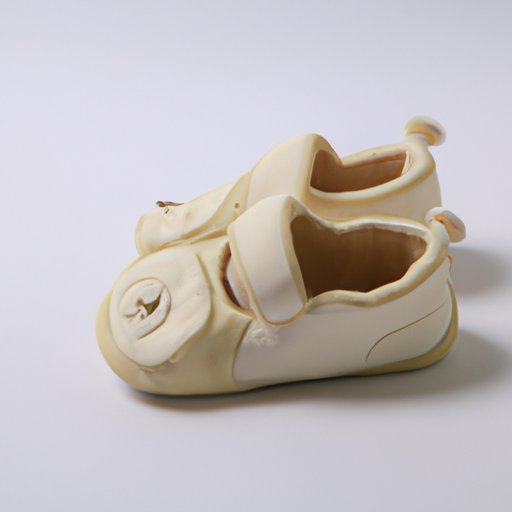Introduction
Putting shoes on babies is a practice that has been around for centuries, and while there are some potential benefits, there are also risks involved. In this article, we will explore the pros and cons of early shoe-wearing for infants, the best types of shoes, when to start putting shoes on babies, and how to choose the right shoes for your baby.
Pros and Cons of Early Shoe-Wearing for Babies
Before deciding when to put shoes on your baby, it’s important to weigh the pros and cons.
Benefits
The primary benefit of putting shoes on babies is protection from the elements. Shoes can protect against cold temperatures, sharp objects, and wet surfaces. They can also help prevent slips and falls, especially when walking on slippery surfaces. Shoes also provide support for the feet and ankles, which can be beneficial for babies who are beginning to walk or are just starting to learn how to balance.
Risks
On the other hand, there are some potential risks associated with putting shoes on babies. Wearing shoes too early can cause the feet to develop improperly, leading to long-term issues such as bunions, hammertoes, and other foot deformities. Shoes can also restrict movement and limit the ability of the feet to develop naturally. Additionally, if the shoes are not properly fitted, they can cause blisters and irritations.
What are the Best Types of Shoes for Infants?
When choosing shoes for your baby, there are three main types to consider: soft soled shoes, hard soled shoes, and shoes with ankle support.
Soft Soled Shoes
Soft soled shoes are generally the best option for babies who are just learning to walk. These shoes are lightweight and flexible, allowing the feet to move freely while still providing some protection. Soft soled shoes are typically made of leather or suede and usually have a rubber sole to provide traction.
Hard Soled Shoes
Hard soled shoes are a good choice for babies who are more confident walkers and need more support than soft soled shoes can provide. Hard soled shoes usually have a thicker sole and a stiffer upper, which can help with stability and balance. However, these shoes can restrict movement, so be sure to look for a pair that still allows for flexibility.
Shoes with Ankle Support
For babies who are already walking well, shoes with ankle support can be beneficial. These shoes are designed to keep the foot in place and provide extra stability and cushioning. They are usually made of leather or canvas and have an elastic band at the ankle for additional support.
When Should Babies Start Wearing Shoes?
When it comes to deciding when to put shoes on babies, there are two main factors to consider: developmental milestones and age guidelines.
Developmental Milestones
Most experts recommend waiting until a baby is confident in their movements before putting shoes on them. This usually occurs around 8-10 months old, when a baby is able to stand up and take a few steps without assistance. It’s also important to wait until the feet have developed enough to fit into shoes properly, which usually happens between 12-18 months old.
Age Guidelines
In general, most pediatricians recommend waiting until a baby is at least 12 months old before putting shoes on them. However, this can vary depending on the individual child. For example, if a baby is crawling a lot or walking earlier than expected, it may be appropriate to start putting shoes on them sooner.
How to Choose the Right Shoes for Your Baby
Once you’ve decided when to put shoes on your baby, it’s important to make sure you choose the right ones. Here are some tips for finding the perfect pair of shoes for your little one:
Comfort
The most important factor to consider when buying shoes for your baby is comfort. Look for shoes that are lightweight and flexible and offer plenty of room for the toes to move. The shoes should also fit snugly but not too tightly.
Fit
It’s important to make sure the shoes fit correctly. Be sure to measure your baby’s feet before shopping and buy shoes that are the correct size. It’s also a good idea to try the shoes on and walk around in them to make sure they are comfortable.
Quality
Finally, make sure you buy shoes that are of good quality. Look for shoes that are made of breathable materials and have a sturdy sole. Avoid shoes with a lot of embellishments, as these can be uncomfortable and can cause blisters.
Conclusion
Putting shoes on babies can be beneficial, but it’s important to understand the pros and cons as well as the best types of shoes and when to start. Soft soled shoes are the best option for babies who are just learning to walk, while hard soled shoes are better for those who are more confident walkers. Most experts recommend waiting until a baby is at least 12 months old before putting shoes on them, but this can vary depending on the individual child. When choosing shoes for your baby, make sure you look for ones that are comfortable, fit correctly, and are of good quality.
With the right information, you can make an informed decision about when to put shoes on your baby and ensure that they are safe and comfortable.


